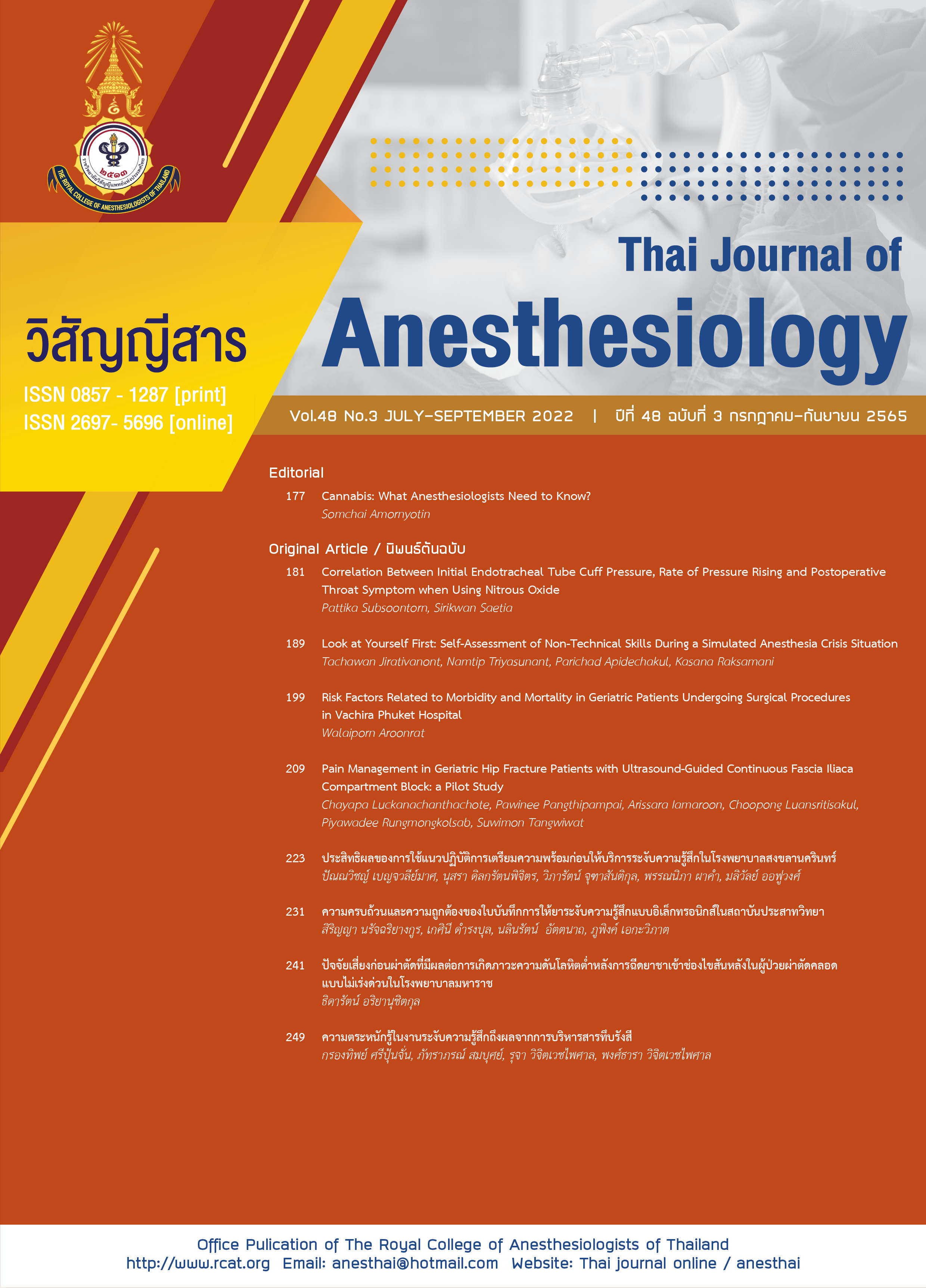Preoperative Risk Factors of Hypotension after Spinal Anesthesia for Elective Cesarean Delivery in Maharat Nakhon Ratchasima Hospital
Main Article Content
Abstract
Background: Spinal block is the popular route of anesthesia for cesarean delivery because it entails fewer risks for the mother and the fetus. Maternal hypotension is a common complication after spinal anesthesia resulting in adverse maternal and fetal outcomes. Objectives: To identify risk factors of hypotension in parturients undergoing cesarean delivery under spinal anesthesia. Methods: This was a prospective observational cohort study of the parturients aged 18-45 years undergoing spinal anesthesia for elective cesarean delivery at Maharat Nakhon Ratchasima Hospital during March 2020 and March 2021. The collected parameters were demographic data, anesthetic data and vital signs after spinal anesthesia. Hypotension was defined as a decrease of systolic blood pressure of more than 20% and less than 90 mmHg. Univariable and multivariable logistic regression were performed for identify risk factors of hypotension after spinal anesthesia. Results: Hypotension was found in 303 from 636 cases (47.6%). Preoperative factors identified the height, BMI, gestational age, estimated baby weight, baseline systolic blood pressure, baseline mean arterial pressure, oxygen saturation and sensory block level as the risk factors of hypotension after spinal anesthesia. The multivariate analysis identified estimated baby weight 2500-3900 gm, >4000 gm and sensory block level >T6 associated with hypotension after spinal anesthesia (adjusted odds ratio 5.29, 8.77 and 1.97). Conclusion: The risk factors associated with increased incidence of hypotension are the estimated baby weight >2500 gm and sensory block level >T6.
Article Details

This work is licensed under a Creative Commons Attribution-NonCommercial-NoDerivatives 4.0 International License.
References
Visalyaputra S. Maternal mortality related to anesthesia: can it be prevent? Siriraj Hosp Gaz. 2002;54:533-9.
Ohpasanon P, Chinachoti T, Srisawasdi P, Srichu S. Prospective study of hypotension after spinal anesthesia for caesarean section at Siriraj Hospital: incidence and risk factors, part 2. J Med Assoc Thai. 2008;91:675-80.
Wanna S, Oranuch K, Somrat C, Arunchai N. Incidence and risk factors of hypotension and bradycardia after spinal anesthesia for cesarean section. J Med Assoc Thai. 2008;91:181-7.
Vercauteren MP, Coppejans HC, Hoffmann VH, Mertens E, Adriaensen HA. Prevention of hypotension by a single 5-mg dose of ephedrine during small-dose spinal anesthesia in prehydrated caesarean delivery patients. Anesth Analg. 2000;90:324-7.
Bajwa SJS, Bajwa SK, Kaur J, Singh A, Singh A, Parmar SS. Prevention of hypotension and prolongation of postoperative analgesia in emergency cesarean section: a randomized study with intrathecal clonidine. Int J Clit Illn Inj Sci. 2012;2:63-9.
Morgan PJ, Halpern SH, Tarshis J. The effects of an increase of central blood volume before spinal anesthesia for caesarean delivery: a qualitative systematic review. Anesth Analg. 2001;92:997-1005.
Roberts SW, Leveno KJ, Sidawi JE, Lucas MJ, Kelly MA. Fetal acidemia associated with regional anesthesia for elective caesarean delivery. Obstet Gynecol. 1995;85:79-83.
Hawkins JL, Chang J, Palmer SK, Gibbs CP, Callaghan WM. Anesthesia-related maternal mortality in the United States: 1979-2002. Obstet Gynecol. 2011;117:69-74.
Kinsella SM, Carvalho B, Dyer RA, et al. International consensus statement on the management of hypotension with vasopressors during caesarean section under spinal anaesthesia. Anaesthesia. 2018;73:71-92.
Chinachoti T, Tritrakarn T. Prospective study of hypotension and bradycardia after spinal
anesthesia with bupivacaine: incidence and risk factors, part two. J Med Assoc Thai. 2007;91: 492-501.
Ivan S, Tonka B, Dubravko H. Spinal anesthesia-induced hypotension in obstetrics: prevention
and therapy. Acta Clin Croat. 2019;58(Suppl1):90-5.
Neal JM. Hypotension and bradycardia during spinal anesthesia: significance, prevention and treatment. Tech Reg Anesth Pain Manage. 2000;4:148-54.
Salinas FV, Sueda LA, Liu SS. Physiology of spinal anaesthesia and practical suggestions for successful spinal anaesthesia. Best Pract Res Clin Anaesthesiol. 2003;17:289-303.
Maayan-Metzger A, Schushan-Eisen I, Todris L, Etchin A, Kuint J. Maternal hypotension during elective caesarean section and short-term neonatal outcome. Am J Obstet Gynecol. 2010;202:56.e1-5.
Okudaira S, Suzuki S. Influence of spinal hypotension on fetal oxidative status during elective caesarean section in uncomplicated pregnancies. Arch Gynecol Obstet. 2005;271:292-5.
Corke BC, Datta S, Ostheimer GW, Weiss JB, Alper MH. Spinal anaesthesia for Caesarean section. The influence of hypotension on neonatal outcome. Anaesthesia. 1982;37:658-62.
Dyer RA, Farina Z, Joubert IA, et al. Crystalloid preload versus rapid crystalloid administration after induction of spinal anaesthesia (coload) for elective caesarean section. Anaesth Intens Care. 2004;32:351-7.
Roofthooft E, Van de VM. Low-dose spinal anaesthesia for Caesarean section to prevent spinal-induced hypotension. Curr Opin Anesthesiol. 2008;21:259-62.
Van Bogaert LJ. Prevention of post-spinal hypotension at elective cesarean section by wrapping of the lower limbs. Int J Gynaecol Obstet. 1998;61:233-8.
Rout CC, Rocke DA. Prevention of hypotension following spinal-anesthesia for caesarean-section. Int Anesthesiol Clin. 1994;32:117-35.
Mohammad RG, Reza A, Hamid AA, Alireza O, Mahbobe R. The effects of pre-spinal anesthesia administration of crystalloid and colloid solutions on hypotension in elective cesarean section. Anesth Pain Med. 2018;8:e69446.
Ngan KWD. Prevention of maternal hypotension after regional anaesthesia for caesarean section. Curr Opin Anaesthesiol. 2010;23:304-9.
Fitzgerald JP, Fedoruk KA, Jadin SM, Carvalho B, Halperm SH. Prevention of hypotension after spinal anaesthesia for cesarean section: a systematic review and network meta-analysis of randomised controlled trials. Anaesthesia. 2020;75:109-21.


